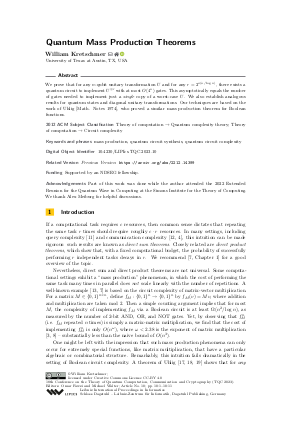Quantum Mass Production Theorems
Author
William Kretschmer 
-
Part of:
Volume:
18th Conference on the Theory of Quantum Computation, Communication and Cryptography (TQC 2023)
Part of: Series: Leibniz International Proceedings in Informatics (LIPIcs)
Part of: Conference: Conference on the Theory of Quantum Computation, Communication and Cryptography (TQC) - License:
 Creative Commons Attribution 4.0 International license
Creative Commons Attribution 4.0 International license
- Publication Date: 2023-07-18
File

PDF
LIPIcs.TQC.2023.10.pdf
- Filesize: 0.76 MB
- 11 pages
Document Identifiers
Related Versions
- Previous Version https://arxiv.org/abs/2212.14399
Subject Classification
ACM Subject Classification
- Theory of computation → Quantum complexity theory
- Theory of computation → Circuit complexity
Keywords
- mass production
- quantum circuit synthesis
- quantum circuit complexity
Metrics
- Access Statistics
-
Total Accesses (updated on a weekly basis)
0Document
0Metadata
Abstract
We prove that for any n-qubit unitary transformation U and for any r = 2^{o(n / log n)}, there exists a quantum circuit to implement U^{⊗ r} with at most O(4ⁿ) gates. This asymptotically equals the number of gates needed to implement just a single copy of a worst-case U. We also establish analogous results for quantum states and diagonal unitary transformations. Our techniques are based on the work of Uhlig [Math. Notes 1974], who proved a similar mass production theorem for Boolean functions.
Cite As Get BibTex
William Kretschmer. Quantum Mass Production Theorems. In 18th Conference on the Theory of Quantum Computation, Communication and Cryptography (TQC 2023). Leibniz International Proceedings in Informatics (LIPIcs), Volume 266, pp. 10:1-10:11, Schloss Dagstuhl – Leibniz-Zentrum für Informatik (2023)
https://doi.org/10.4230/LIPIcs.TQC.2023.10
BibTex
@InProceedings{kretschmer:LIPIcs.TQC.2023.10,
author = {Kretschmer, William},
title = {{Quantum Mass Production Theorems}},
booktitle = {18th Conference on the Theory of Quantum Computation, Communication and Cryptography (TQC 2023)},
pages = {10:1--10:11},
series = {Leibniz International Proceedings in Informatics (LIPIcs)},
ISBN = {978-3-95977-283-9},
ISSN = {1868-8969},
year = {2023},
volume = {266},
editor = {Fawzi, Omar and Walter, Michael},
publisher = {Schloss Dagstuhl -- Leibniz-Zentrum f{\"u}r Informatik},
address = {Dagstuhl, Germany},
URL = {https://drops.dagstuhl.de/entities/document/10.4230/LIPIcs.TQC.2023.10},
URN = {urn:nbn:de:0030-drops-183206},
doi = {10.4230/LIPIcs.TQC.2023.10},
annote = {Keywords: mass production, quantum circuit synthesis, quantum circuit complexity}
}
Author Details
Funding
Supported by an NDSEG fellowship.
Acknowledgements
Part of this work was done while the author attended the 2022 Extended Reunion for the Quantum Wave in Computing at the Simons Institute for the Theory of Computing. We thank Alex Meiburg for helpful discussions.
References
- Scott Aaronson and Daniel Gottesman. Improved simulation of stabilizer circuits. Phys. Rev. A, 70:052328, November 2004. URL: https://doi.org/10.1103/PhysRevA.70.052328.
- Andreas Albrecht. On simultaneous realizations of Boolean functions, with applications. In Gottfried Wolf, Tamáas Legendi, and Udo Schendel, editors, Parcella '88, pages 51-56, Berlin, Heidelberg, 1989. Springer Berlin Heidelberg. URL: https://doi.org/10.1007/3-540-50647-0_102.
- Josh Alman and Virginia Vassilevska Williams. A refined laser method and faster matrix multiplication. In Proceedings of the 2021 ACM-SIAM Symposium on Discrete Algorithms (SODA), pages 522-539, 2021. URL: https://doi.org/10.1137/1.9781611976465.32.
- Boaz Barak, Mark Braverman, Xi Chen, and Anup Rao. How to compress interactive communication. In Proceedings of the Forty-Second ACM Symposium on Theory of Computing, STOC '10, pages 67-76, New York, NY, USA, 2010. Association for Computing Machinery. URL: https://doi.org/10.1145/1806689.1806701.
- Matthias C. Caro. Learning quantum processes and Hamiltonians via the Pauli transfer matrix, 2022. URL: http://arxiv.org/abs/2212.04471.
- Sitan Chen, Jordan Cotler, Hsin-Yuan Huang, and Jerry Li. Exponential separations between learning with and without quantum memory. In 2021 IEEE 62nd Annual Symposium on Foundations of Computer Science (FOCS), pages 574-585, 2022. URL: https://doi.org/10.1109/FOCS52979.2021.00063.
- Andrew Donald Drucker. The complexity of joint computation. PhD thesis, Massachusetts Institute of Technology, 2012. URL: http://dspace.mit.edu/handle/1721.1/7582.
- Ran Duan, Hongxun Wu, and Renfei Zhou. Faster matrix multiplication via asymmetric hashing, 2022. URL: http://arxiv.org/abs/2210.10173.
- Shuichi Hirahara. NP-hardness of learning programs and partial MCSP. In 63rd IEEE Annual Symposium on Foundations of Computer Science, FOCS 2022, Denver, CO, USA, October 31 - November 3, 2022, pages 968-979. IEEE, 2022. URL: https://doi.org/10.1109/FOCS54457.2022.00095.
- Hsin-Yuan Huang, Michael Broughton, Jordan Cotler, Sitan Chen, Jerry Li, Masoud Mohseni, Hartmut Neven, Ryan Babbush, Richard Kueng, John Preskill, and Jarrod R. McClean. Quantum advantage in learning from experiments. Science, 376(6598):1182-1186, 2022. URL: https://doi.org/10.1126/science.abn7293.
- Rahul Jain, Hartmut Klauck, and Miklos Santha. Optimal direct sum results for deterministic and randomized decision tree complexity. Information Processing Letters, 110(20):893-897, 2010. URL: https://doi.org/10.1016/j.ipl.2010.07.020.
- Rahul Jain, Jaikumar Radhakrishnan, and Pranab Sen. A direct sum theorem in communication complexity via message compression. In Jos C. M. Baeten, Jan Karel Lenstra, Joachim Parrow, and Gerhard J. Woeginger, editors, Automata, Languages and Programming, pages 300-315, Berlin, Heidelberg, 2003. Springer Berlin Heidelberg. URL: https://doi.org/10.1007/3-540-45061-0_26.
- Wolfgang J. Paul. Realizing Boolean functions on disjoint sets of variables. Theoretical Computer Science, 2(3):383-396, 1976. URL: https://doi.org/10.1016/0304-3975(76)90089-X.
- Hanlin Ren and Rahul Santhanam. Hardness of KT Characterizes Parallel Cryptography. In Valentine Kabanets, editor, 36th Computational Complexity Conference (CCC 2021), volume 200 of Leibniz International Proceedings in Informatics (LIPIcs), pages 35:1-35:58, Dagstuhl, Germany, 2021. Schloss Dagstuhl - Leibniz-Zentrum für Informatik. URL: https://doi.org/10.4230/LIPIcs.CCC.2021.35.
- Claude. E. Shannon. The synthesis of two-terminal switching circuits. The Bell System Technical Journal, 28(1):59-98, 1949. URL: https://doi.org/10.1002/j.1538-7305.1949.tb03624.x.
- Vivek V. Shende, Stephen S. Bullock, and Igor L. Markov. Synthesis of quantum-logic circuits. IEEE Transactions on Computer-Aided Design of Integrated Circuits and Systems, 25(6):1000-1010, 2006. URL: https://doi.org/10.1109/TCAD.2005.855930.
- Dietmar Uhlig. On the synthesis of self-correcting schemes from functional elements with a small number of reliable elements. Matematicheskie Zametki, 15(6):937-944, 1974. In Russian. URL: http://mi.mathnet.ru/mz7425.
- Dietmar Uhlig. On the synthesis of self-correcting schemes from functional elements with a small number of reliable elements. Mathematical notes of the Academy of Sciences of the USSR, 15(6):558-562, 1974. Translated from Russian. URL: https://doi.org/10.1007/BF01152835.
- Dietmar Uhlig. Networks Computing Boolean Functions for Multiple Input Values, pages 165-173. London Mathematical Society Lecture Note Series. Cambridge University Press, 1992. URL: https://doi.org/10.1017/CBO9780511526633.013.
